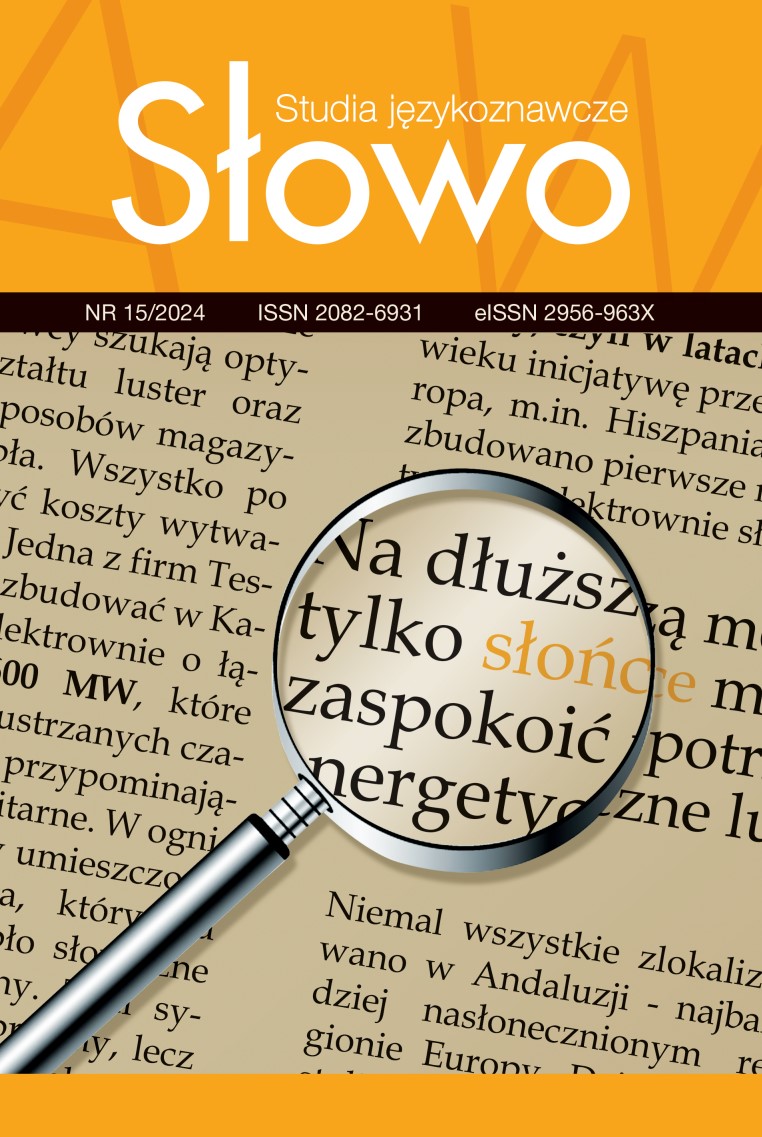Metonimiczne operacje w przysłowiach z nazwami miejsc
DOI:
https://doi.org/10.15584/slowo.2024.15.6Słowa kluczowe:
metaftonimia, łańcuch metonimiczny, metonimia (wewnętrzna, zewnętrzna), nazwy miejsc, przysłowiaAbstrakt
W przypadku motywacji przysłów w semantyce kognitywnej pojawiają się dwie kontrastujące perspektywy. Z jednej strony, przysłowia są postrzegane jako metaforycznie uwarunkowane – ze względu na działanie metafory ogólne to konkretne , a z drugiej, z uwagi na ich konceptualny charakter, mogą być interpretowane jako metonimiczne – wizualizując ogólną konceptualną metonimię konkretne to ogólne. W artykule wzięto pod uwagę metonimiczne konceptualizacje zawarte w przysłowiach pochodzących z różnych języko-kultur, które zawierają nazwy miejsc. W analizowanych przykładach zidentyfikowano następujące typy metonimii: miejsce to mieszkańcy (np. It takes a whole village to bring up a child [dosł. Potrzeba całej wioski, żeby wychować dziecko]), miejsce to instytucja (np. The nearer the church, the farther from God [dosł. Im bliżej kościoła, tym dalej od Boga]), miejsce to wydarzenie (np. Every man meets his Waterloo at last [dosł. Każdy człowiek w końcu spotyka swoje Waterloo]), miejsce to aktywność wykonywana w danym miejscu (np. What happens in Vegas stays in Vegas [dosł. Co się dzieje w Vegas, zostaje w Vegas]), miejsce to produkt wykonany w danym miejscu (np. China and reputations are alike: easily cracked but not easily mended [dosł. Chiny {Porcelana} i reputacja są do siebie podobne: łatwo je złamać, ale niełatwo je naprawić). Materiał badawczy służy ponadto jako medium do ukazania mechanizmu zarówno wewnętrznej, jak i zewnętrznej metonimii, jak również innych procesów kognitywnych, takich jak łańcuch metonimiczny, metaftonimia i metafora orientacyjna.
Downloads
Bibliografia
Arewa, E., Dundes, A. (1964). Proverbs and the ethnography of speaking folklore. American Anthropologist, 66(6), 70–85.
Arimitsu, N. (2015). Analysing the place for event -type metonymies from the perspective of negative evaluative factors. Revista Brasileira de linguística aplicada. 15(2), 475–502.
Barcelona, A. (2000). The cognitive theory of metaphor and metonymy. In: A. Barcelona (ed.), Metaphor and metonymy at the crossroads. A cognitive perspective (pp. 1–28). New York, NY: Mouton de Gruyter.
Barcelona, A. (2005). The multilevel operation of metonymy in grammar and discourse, with particular attention to metonymic chains. In: F.J. Ruiz de Mendoza Ibáñez, S. Peña Cervel (eds.), Cognitive linguistics: Internal dynamics and interdisciplinary interaction (pp. 313–352). Berlin, New York: The Gruyter Mouton.
Bauman, R., McCabe, N. (1970). Proverbs in an LSD cult. The Journal of American Folklore, 83(329), 318–324.
Bierwiaczonek, B. (2014). Conceptual blending in the interpretation of proverbs. Linguistica Silesiana, 35, 101–117.
Brdar, M. (2015). Metonymic chains and synonymy. Fluminensia, 27(2), 83–101.
Diez, O. (2001–2002). Metaphor, metonymy, and image schemas: An analysis of conceptual interaction patterns. Journal of English Studies, 3, 47–63.
Frisson, S., Pickering, M. (1999). The processing of metonymy: evidence from eye movements. Journal of Experimental Psychology: Learning, Memory, and Cognition, 25, 1366–1383.
Gibbs, R.W. Jr., Colston, H.L., Johnson, M.D. (1996a). Proverbs and the metaphorical mind. Metaphor and Symbolic Activity, 11, 207–216.
Gibbs, R.W. Jr., Colston, H.L., Johnson, M.D. (1996b). How to study proverb understanding. Metaphor and Symbolic Activity, 11, 233–239.
Goossens, L. (1990). Metaphtonymy: The interaction of metaphor and metonymy in expressions for linguistic action. Cognitive Linguistics, 1(3), 323–342.
Gove, P.B. et al. (eds.) (1971). Webster’s third new international dictionary of the English language. Chicago: Merriam Co.
Hofschröer, P. (1999). 1815: The Waterloo campaign. The German victory. Vol. 2. London: Greenhill Books.
Kiełtyka, R. (2020). The role of historical context responsible for the figurative use of common words derived from place-names. Lege Artis. Language yesterday, today, tomorrow. The journal of University of SS Cyril and Methodius in Trnava, V(1), 54–98.
Kochman-Haładyj, B., Kiełtyka, R. (2023). Paradigm shift in the representation of women in Anglo-American paremiology – a cognitive semantics perspective. Studies in Logic, Grammar and Rhetoric, 68, 41–77.
Kövecses, Z. (2006). Language, mind and culture: A practical introduction. Oxford: Oxford University Press.
Kövecses, Z. (2015). Where metaphors come from. Reconsidering context in metaphor. Oxford, England: Oxford University Press.
Kövecses, Z., Radden, G. (1999). Towards a theory of metonymy. In: K.-U. Panther, G. Radden (eds.), Metonymy in language and thought (pp. 17–59). John Benjamins Publishing Company.
Lai, H. (2008). Understanding and classifying two-part allegorical sayings: Metonymy, metaphor, and cultural constraints. Journal of Pragmatics, 40(3), 454–474.
Lakoff, G., Johnson, M. (1980). Metaphors we live by. Chicago, London: University of Chicago Press.
Lakoff, G., Turner, M. (1989). More than cool reason. A field guide to poetic metaphor. Chicago: University of Chicago Press.
Lemghari, E.M. (2019). A metonymic-based account of the semiotic status of proverbs: Against the “deproverbialization thesis”. The Linguistics Journal, 13(1), 30–51.
Littlemore, J. (2015). Metonymy. Hidden shortcuts in language, thought and communication. Cambridge: Cambridge University Press.
Maalej, Z. (2009). A cognitive-pragmatic perspective on proverbs and its implications for translation. International Journal of Arabic-English Studies, 10, 135–154.
Mieder, W. (1982). Proverbs in Nazi Germany: The promulgation of anti-semitism and stereotypes through folklore. The Journal of American Folklore, 95(378), 435–464.
Moreno, A. (2005). An analysis of the cognitive dimension of proverbs in English and Spanish: The conceptual power of language reflecting popular believes. SKASE Journal of Theoretical Linguistics, 2, 42–54.
Masegosa, A.G. (2010). Metaphoric complexes: A Spanish-English contrastive analysis of metaphor and metonymy in interaction. RESLA, 23, 175–193.
Panther, K.-U., Thornburg, L. (1999). The potentiality for actuality metonymy in English and Hungarian. In: K.-U. Panther, G. Radden (eds.), Metonymy in language and thought (pp. 333–357). John Benjamins Publishing Company.
Radden, G. (2002). How metonymic are metaphors? In: R. Dirven, R. Porings (eds.), Metaphor and metonymy in comparison and contrast (pp. 407–434). Berlin, New York: Mouton de Gruyter.
Radden, G., Kövecses, Z. (2007). Towards a theory of metonymy. In: V. Evans, B. Bergen, J. Zinken, The cognitive linguistics reader (pp. 335–359). London: Equinox.
Radden, G., Köpcke, K.-M., Berg, T., Siemund, P. (2007). The construction of meaning in language. In: G. Radden, K.-M. Köpcke, T. Berg, P. Siemund (eds.), Aspects of meaning construction (pp. 1–15). Amsterdam: John Benjamins Publishing Company.
Ruiz de Mendoza, F.J. (2001). Metonymy and the grammar. Language and Communication, 21(4), 321–357.
Ruiz de Mendoza, F.J. (2021). Conceptual metonymy theory revisited: Some definitional and taxonomic issues. In: X. Wen, J. Taylor (eds.). The Routledge handbook of cognitive linguistics (pp. 204–227). London, New York: Routledge.
Ruiz de Mendoza, F.J., Galera, A. (2014). Cognitive modelling: A linguistic perspective. Philadelphia, PA: John Benjamins Publishing Company.
Ruiz de Mendoza, F.J., Diez, V. (2002). Patterns of conceptual interaction. In: R. Dirven, R. Pörings (eds.), Metaphor and metonymy in comparison and contrast (pp. 489–532). Berlin: Mouton de Gruyter.
Speake, J. (2015). Oxford dictionary of proverbs. Oxford: Oxford University Press.
Sullivan, K., Sweetser, E. (2010). Is ‘Generic is Specific’ a metaphor? In: P. Fey, V. Tobin, M. Turner (eds.), Meaning, form and body (pp. 309–328). Standford: CSLI.
Szpila, G. (2020). Metonymic operations in Polish proverbs. Proverbium, 22, 403–414.
Temple, J., Honeck, R. (1999). Proverb comprehension: the primacy of literal meaning. Journal of Sociolinguistic Research, 28(1), 41–70.
Cambridge dictionary. Retrieved from: https://dictionary.cambridge.org/dictionary/english/can-t-see-the-wood-for-the-trees (18.01.2024).
Collins dictionary. Retrieved from: https://www.collinsdictionary.com/dictionary/english/church (18.01.2024).
Merriam-Webster dictionary. Retrieved from: https://www.merriam-webster.com/dictionary/village
(4.11.2024).
Phrase finder. Retrieved from: https://www.phrases.org.uk/meanings/245800.html (22.02.2024).
Proverb hunter. Retrieved from: https://proverbhunter.com/the-nearer-the-church-the-farther-from-god/ (18.01.2024).
The Franklin institute. Retrieved from: https://fi.edu/en/science-and-education/benjamin-franklin/famous-quotes (6.05.2024).
The free dictionary by Farlex. Retrieved from: https://idioms.thefreedictionary.com/nearer+the+church%2C+the+farther+from+God (18.01.2024).
UNESCO. Retrieved from: https://en.unesco.org/silkroad/content/chinese-porcelain (6.05.2024).
Pobrania
Opublikowane
Jak cytować
Numer
Dział
Licencja
Prawa autorskie (c) 2024 Słowo. Studia językoznawcze

Utwór dostępny jest na licencji Creative Commons Uznanie autorstwa – Użycie niekomercyjne 4.0 Międzynarodowe.


